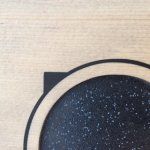Thanks Allen for the advise...the parts I didnt make any smaller I actually thought I might have to.. maybe the cutter is so small that it bends about a tad at high speed as the part push fit in pretty well.
However the rosewood was the second attempt as the first piece started to curl upwards dramatically when only secured in the centre with couple of screws so was scrapped! I am new to working with wood on this scale and supprised at just how bent and twisted it became maybe its the heat from cutting or just making tensions but hey was shocked!
This one was screwed the centre plus tiny pins the corners and even then it wanted to curl but ended up okay. I think theres play in the machine as it was about 0.1mm different in one direction which is about the tolerance given for this type of intermediate cnc router bed.... that said I think it seems okay... i ve never used super glue for wood working so it was titebond and sanding and outcome is pictured here. Think theres tiny bit of tear out but only couple of fibres which hope when taken down with a scraper once the outers parts are in place also. I ve tried the hot glue at times but think maybe my workshop in the uk just cold for it!
As for sequoia's outrageous comment about tea! That's fighting talk to an Englishman! Though tea has to be made with the right water and full fat milk of course or it is rubbish! But tea in england actually means also your evening meal also so thats what I was doing with the kids.... think with cup of tea my kids would be even more crazy than they are now (5 year old twins).
And I agree about the hand tools and quiet calm of using them and I even use a hand drill when I can as don't like the noise or the dust when making stuff. Good thing about this router is its enclosed with extraction so the dust is fairly non existent in the air so no cough or hack thank god as I have enough coughing from my bio hazard twins.
Anyway I am interested in design feedback also along the way...... I think decoration on ukes are like tattoos on people they have to be done well and done to fit the body shape not just plonked on with no relationship to the form. I will try to make my ukes like a sharp smart tailored suit rather than a fashion fad product.... thats the aim, hope I dont miss!
I d like to see a few more pics of stuff being made on here rather than the finished thing as the process and problem solving holds the fascination for more me along with the outcome!
I d like to know if its the challenge of making and problem solving along the way that other find interesting or the outcome of the luvly ukes?











